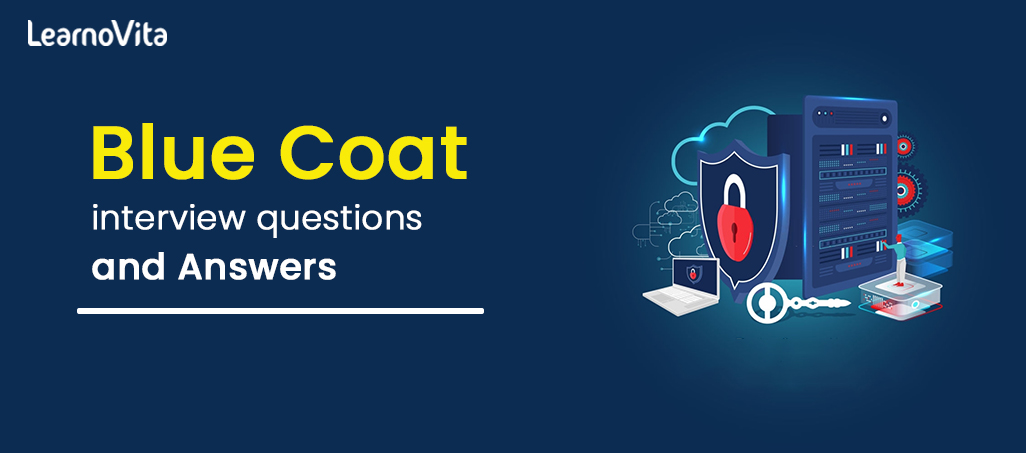
[30+] Filenet Interview Questions and Answers [ FRESHERS ]
Last updated on 24th Dec 2022, Blog, Interview Question
1. What’s Filenet Technology?
Ans:
FileNet is an associate degree Enterprise Content Management (ECM) answer product suite from IBM.
FileNet P8 platform, the newest version of FileNet system, provides a framework for developing custom enterprise systems, giving abundant practicality out of the box and capable of being customized to manage a particular business method.
2. What’s Document Lifecycle?
Ans:
Document lifecycle in FileNet P8 could be a sequence of states (like Draft, Review, Publish, shut etc) that a document can go through over its period, further because the action that area unit triggered once document moves from one state to a different. A user or application will move the doc forward or backward in its lifecycle.
3. Will Filenet element Ce, Pe, Ae Support Server bunch? What quite Clustering Is Supported By Filenet P8?
Ans:
- FileNet P8 platform supports uneven, Symmetric, N + 1, and N to M clusters. This includes FileNet Content Engine, method Engine and Application Engine.
- Asymmetric clusters embrace each active and passive server. i.e. just in case of an uneven 1-to-1 cluster, there’s one active and another passive server. This is often the simplest kind of bunch.
- Symmetric clusters embrace all the active servers. In interchangeable clusters totally {different|completely different} servers run different services however just in case of failover, multiple services area units are affected on to at least one server.
4. That Protocol is employed By Filenet P8 method Engine (pe) to attach To Content Engine (ce) Or Application Engine (ae)?
Ans:
- IIOP is employed by letter to speak with Ce and AE.
- IIOP means that ‘Internet Inter-ORB Protocol’.
- ORB means that ‘Object Request Broker’.
- As Ce is put in on AE, it uses direct API calls to speak with AE.
5. In what number of Databases will Filenet Content Engine (ce) Store Data?
Ans:
FileNet Content Engine (CE) has 2 or additional databases:
- Global Configuration info (GCD) info (FNGCDDB).
- Object Store databases (one or more).
- A FileNet P8 domain will contain one or several object stores. every object store has its own info that may well be existing info or is created by object store creation wizard in FEM.
6. Wherever Filenet Content Engine (ce) Physically Stores Documents?
Ans:
FileNet Content Engine is organized to store documents at following places:
- In info as blobs (IBM counseled most document size to store as blob is ten KB).
- In File Store.
- In read-only storage Devices (like EMC Centera).
7. What’s Fn P8 Domain?
Ans:
The FileNet P8 domain represents a logical grouping of physical resources (such as object stores) further because the Content Engine servers that give access to those resources. A server will access any resource within the domain, however cannot access any resource that lies outside of the domain. The Ce international Configuration knowledge (GCD) info stores info concerning the resources and services for the FileNet P8 Domain.
8. What’s File Store And File Store Policy?
Ans:
File Store is the physical folder wherever FileNet stores documents. Multiple File Stores are created to store documents at 2 totally different places. This kind of setup is termed File Store Farm. File Store Policy permits distribution of documents in File Store Farm.
9. What’s the employment Of Content Engine Question Builder?
Ans:
CE question Builder permits FileNet users to seek out Content Engine objects and to hold out bulk operations on them. Question Builder is a component of FileNet Enterprise Manager (FEM) software system that comes with FileNet Content Engine installable.
The basic practicality of question Builder includes:
- Find objects’ mistreatment property values as search criteria.
- Create, save and run straightforward searches.
- Create and save search templates which will prompt for criteria once launched.
- Launch search templates that area unit given every Content Engine and Enterprise
- Manager installation.
- Create, save, and run SQL queries.
- The question Builder searches is combined with bulk operations that embrace the subsequent actions, obtainable on the question.
Builder’s Actions tab:
- Delete objects.
- Add objects to the export manifest.
- Undo documents checkout.
- Run VBScripts or JScripts.
- Edit security by adding or removing users and teams together with enable and deny permissions.
10. What’s Filenet p8 White paper?
Ans:
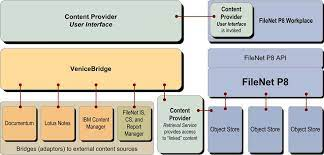
11. A way to confirm If Filenet Content Engine (ce) Is Running Fine?
Ans:
Following area unit few things one will check to seek out out if FileNet cerium is running fine:
- Check WebSphere console for ‘FileNetEngine’ net application standing. It ought to be in running state.
- Try connecting to cerium victimization FEM. If affiliation is ok cerium is running. If cerium isn’t running, the user can get the message ‘Unable to logon to P8 domain’.
- Try login to FileNet geographical point. If the user is in a position to check in, the cerium & directory services are running fine. If not, the user can get a ‘credential exception’.
12. Will Filenet Cerium offer Content Compression Or Encryption?
Ans:
No. The FileNet P8 five.1 unharness supports this coding feature that helps to guard the content from unauthorized access.
13. However Authentication Is handled In Filenet P8?
Ans:
Authentication may be a method of checking if the user entered credentials are correct. FileNet P8 uses 2 completely different standards for authentication:
Java Authentication and Authorization Service (JAAS) commonplace JAAS provides a policy-based framework to work out a United Nations agency invoking a Java application. The Content Engine EJB resides at intervals the J2EE Application Server’s EJB instrumentality. cerium uses JAAS pluggable framework for authentication.
Web Services Security (WS-Security) commonplace FileNet net services uses WS-Security standards for authentication. Like JAAS, WSSecurity is Associate in Nursing protrusile commonplace that supports multiple security token formats i.e.
When the Content Engine server receives an online service request, the Content Engine net Service attender extracts the WS-Security header and performs a JAAS login supporting its contents. If this JAAS login is roaring, then the online service attender passes the request onto the Content Engine EJB layer at intervals the EJB instrumentality.
14. What’s Content Engine net Services (cews)?
Ans:
- Communication with FileNet Content Engine (CE) will occur through the EJB transport or Content Engine net Services (CEWS) transport.
- Web services are usually utilized by loosely coupled frameworks like service-oriented design for connecting parts. IBM FileNet Content Manager provides ceriumWS for accessing nearly all options obtainable within the CE server.
- A Web Services Description Language (WSDL) file is provided by FileNet to use an online services interface. CEWS purchasers (stub classes) will be generated from these WSDL files.
15. Why Use Custom Objects Once We Have a Content-less Document?
Ans:
Custom objects area unit for making composite objects. It will contain content-less documents, i.e. solely information in addition to different document categories and/or custom objects as its properties.
16. What’s element Queue and the way To assemble element Queue In Filenet?
Ans:
Component queues build it attainable to method a workflow step victimization Associate in Nursing external entity, like a JavaTM object or Java Message Service (JMS). victimization method Configuration Console, you assemble an element queue with Associate in Nursing device, either Java or JMS. The Java device permits you to reveal public strategies from a Java category as operations on a queue. The JMS device permits you to publish workflow knowledge to a JMS queue, additionally victimization operations. victimization method Designer, the workflow author adds an element step to a map and selects operations for that step from the list of element queues. The work flow author additionally specifies the suitable expression for every operation parameter.
17. What area unit holds on Search And Search Template?
Ans:
Workplace offers object search to assist users quickly find the things they’re trying to find. Multiple choices area units obtainable to geographical point users for looking out objects held on in FileNet Content Engine together with easy search, hold on search, search templates etc.
By default the straightforward search is obtainable to users. victimization easy search users will produce made-to-order searches for documents, folders, and custom objects. The search criteria and choices will be organized victimization the Search read of the User Preferences page of geographical point.
Both hold on searches and search templates area unit predefined searches organized by directors victimization Search Designer tool.
18. What area unit Root categories In Filenet?
Ans:
A root category may be a category while not a parent. FileNet object store has multiple root categories together with Document category, Annotation, selection List, Event etc. The ‘Parent Class’ property of those root categories is ‘None’ (as shown in below screenshot).
The root categories area unit is created mechanically throughout object store creation. Once the foundation category is formed, subclasses and properties will be additional to the thing store.
For example, a document taxonomic category will be additional below root category (Document Class) by running the produce a category wizard from Enterprise Manager.
Except the ‘Document Class’, all different root categories area unit places below ‘Other Classes’ in Enterprise Manager as shown in below screenshot.
19. What’s The Distinction Between File Store And Object Store?
Ans:
- An OBJECT STORE may be an info repository for storing objects.
- But FILE STORE deals with at that it hold on format sort.
- File systems that are units used for file stores should use the NFS or CIFS protocol.
20. In what number of Databases will the Filenet method Engine (pe) Stores Data?
Ans:
FileNet method Engine (PE) stores knowledge into 1 info named VWDB.
21. Make a case for FileNet Application Engine Architecture?
Ans:
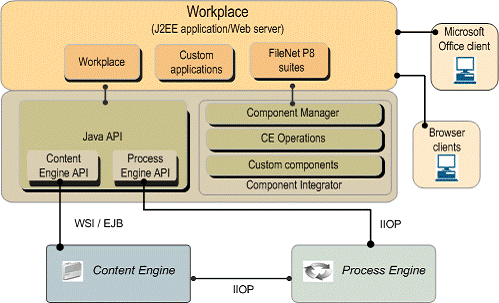
22. What’s AN Isolated Region?
Ans:
An isolated region could be a logical subdivision of the progress info that contains the queues for the work things, event logs, rosters, and alternative configuration data.
Below area unit few facts concerning isolated region:
- FileNet method Engine have Isolated Regions.
- ‘Process Configuration Console (PCC)’ is employed to form and manage Isolated Regions.
- One alphabetic character will have multiple Isolated Regions.
- Multiple Isolated Regions cannot connect with the same Content Engine (CE).
- Initializing a new Isolated Region creates a default structure as Inbox, default list and event log.
- A supervisor uses FileNet Enterprise Manager (FEM) to outline the isolated region. A method Engine host, the communication purpose, a password, and isolated region range area unit needed to outline isolated regions in metallic elements.
23. Why can we want Multiple ‘isolated Regions’?
Ans:
An isolated region could be a logical subdivision of the progress info in FileNet method Engine.
Different units in a company UN agency don’t need to share progress information and will produce totally different isolated regions.
For example the analysis department and therefore the finance department in a company have 2 all at once logically totally different processes. it’s suggested to own 2 totally different isolated regions for these 2 departments.
Multiple isolated regions conjointly build it straightforward to take care of the systems. Changes created into one region don’t have an effect on the users of another region.
24. What area unit differing types Of Queues In method Engine?
Ans:
Process Engine (PE) queues hold the work things waiting to be processed. The queues in alphabetic character may be managed using the exploitation method Configuration Console (PCC). alphabetic character has four differing types of queues:
User Queues:User queues hold work things allotted to a user or being half-tracked by a user. There are 2 totally different forms of user queues created once AN Isolated Region is initialized.
Work Queues:Work queue holds work items which may be processed by one or several users as a part of a gaggle.
Component queue:Component queue holds work things to be processed by part step in progress. The elements step area unit to method a piece item exploitation AN external part.
System Queues:Internally utilized by method Engine, System queues don’t seem to be accessible to the users or directors. Conductor, Delay, and InstructionSheet Interpreter area unit few of the samples of system.
25. A way to Delete A Queue In Method Engine?
Ans:
FileNet doesn’t give any mechanism to delete a queue; whether or not it’s a piece queue or a part queue.
- Export isolated region configuration information to XML – Use method Configuration Console (PCC) to export all elements of selected isolated region.
- Initialize an isolated region.
- Take a backup of the XML file from the export in step one and punctiliously edit the XML file to get rid of the nodes of unwanted queue.
- Import the XML move into recently initialized isolated regions with the choice ‘overwrite’.
- Validate the configuration.
- FileNet developers ought to style and tack together the queues terribly rigorously to avoid a state of affairs wherever they’ll have to be compelled to delete a queue.
26. What Happens To The Work Things Once A Piece Queue Is Deleted From Pe?
Ans:
- The Process Engine work queue holds the work things. FileNet P8 doesn’t give any easier thanks to delete a queue.
- Queues may be deleted by initializing the isolated region. once a queue is deleted all the work things in it are deleted.
27. What’s The Distinction Between A List And A Queue?
Ans:
There is no gross distinction in querying a queue or a list. Each could be a table and therefore the issue in querying them is going to be supported by the quantity of things required to be reviewed by the info, the hassle in deconstructing what has to be came and therefore the range of objects that area unit came from.
A list is employed to search out work. It represents work that might be in any range of various queues. Otherwise you’d have to be compelled to scan every queue to search for work. Think about it as an operation to your work in spite of the queue. A queue is employed to separate similar work for similar actions.It’s rare to appear for work via a queue as a list is additional economical. To method work you either grasp the queue it’s in (inbox vogue application), or look it up within the list and so method it. you mostly come back to queue components or list components in an exceedingly question wherever you don’t skill several things. this can be merely a comeback of columns within the table.
28. What’s the employment Of method Administrator?
Ans:
- FileNet method Administrator permits FileNet administrator to look at and manage add progress.
- Process Administrator could be a Java application program primarily based on UI and may be invoked from IBM Workplace’s admin section.
- Following tasks may be performed tho’ method Administrator: Search workflows, work items, progress events, and progress statistics.
29. Wherever to search out data concerning The Workflows Or Work things that area units Terminated?
Ans:
The FileNet method Administrator permits administrators to go looking for events in event logs. The knowledge concerning the terminated work things may be found tho’ method Administrator by hunt for events.
30. What’s CM Farm in Filenet?
Ans:
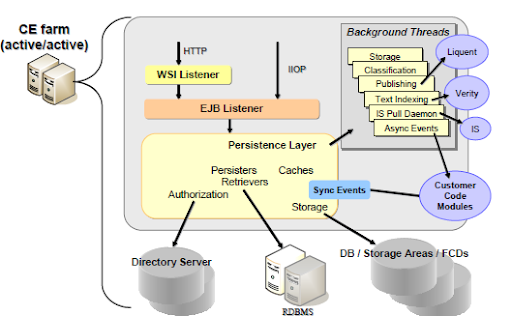
31. What’s The Distinction Between A Document And A Record In Filenet Terms?
Ans:
- A document could be a file that you simply will produce, save, and afterwards retrieve and update, substituting the previous version with the updated version.
- A record could be a relation to data and provides information to manage the data. Records will be electronic or physical (i.e. a document held in Ce or a physical book).
- A document that is further to Associate in Nursing IBM FileNet P8 content repository, however it’s not nonetheless declared as a record is named as ‘document’, not a record.
- As presently because the document is asserted as a record, we have a tendency to think about the document as a record.
- Document objects square measure hold on within the Records-enabled content Object Store (ROS) and also the corresponding record objects square measure hold on within the File arrange Object Store (FPOS).
32. Ought All The Properties Of Ce Replicated To Rm?
Ans:
No. One ought to avoid duplicating the properties unless and till it represents a selected demand. Properties that have practical want for document management ought to be utilized in Ce, whereas properties that have practical want for records management ought to be utilized in RM. If a property happens to be required for each, then it ought to exist in each. Several electronic warfare architects use the precise same properties in ROS (CE) and FPOS (RM) for simplicity.
33.Explain the employment of FileNet Consistency Check utility.
Ans:
The FileNet Consistency Check tool could be a utility as a part of FileNet Enterprise Management (FEM). It verifies files held on within the FileStore correspond to the information within the Ce information or not. It ensures information consistency over common use events like system restore, power loss, system crash.
34. Will FileNet Ce give content compression or encryption?
Ans:
No.The FileNet P8 five.1 unharness supports this encoding feature that helps to guard the content from unauthorized access. If you’ve got any doubts on IBM Filenet, then get them processed from IBM Filenet trade consultants on our IBM.
35.Why use custom objects after you have a content-less document?
Ans:
Custom objects will be made-to-order as {they square measure|they’re} all-purpose objects whereas document objects contain information and content as its objects are instances of the document category.
Content-less documents square measure utilized in pursuit of physical things like Video Tapes, books, etc. This document contains the properties however has no content.
Custom objects don’t seem to be versionable. If versioning is needed then acceptable categories are outlined in document category hierarchy and objects square measure hold on within the content-less documents.
36. What happens to the work once a piece queue is deleted from PE?
Ans:
The work things are unbroken on hold within the method Engine work queue. The queues square measure deleted once initializing the isolated region. Once the queue is deleted then all the associated work things in it conjointly get deleted.
37.Where are you able to realize the terminated workflows or work items?
Ans:
The administrator was able to look for events within the event logs obtainable within the FileNet method Administrator. The terminated work things square measure found through the method administrator by looking out the data regarding these events.
38. What square measures the kinds of queues obtainable within the method Engine?
Ans:
There square measure four differing types of queues gift within the method Engine.
Work queues : The work things expect for processes within the work queues. It ensures the quick process of things within the work queues.
Component queues : part queues method the advancement steps by configuring with external entities like Java Message Service, method Configuration management.
System queues : The system queues square measure the queues which might be accessed solely by the method Engine.
User queues : The user queues hold the work things that square measure assigned to users or half-track by the users. Inbox and hunter square measure 2 queues that square measure created mechanically once initializing an isolated region.
39.Describe the various ways in which to secure documents in FileNet Ce.
Ans:
There square measure 2 ways in which in securing the documents in FileNet Ce:
1.Access management List:The Access management List defines the access rights provided to the users that embody viewing, change the content, publishing, updating, access rights and information. Associate in Nursing authorization framework assigns the access rights to the user teams or users supported organized LDAP repositories.
2.Marking sets:The Marking sets outline the extent of security for the objects. Access to things is controlled by victimization, the marking sets supported providing the particular property values.
40.Define root categories in FileNet.
Ans:
A category that doesn’t have any parent category is named a root class. The FileNet object store contains numerous root categories like an occasion, selection list, annotation, document category etc. the foundation categories square measure created mechanically once the thing store is formed. Once making the foundation category the properties and subclasses will be outlined or further to the object-store.
41.What is the distinction between the key Version and Minor Version?
Ans:
Content Engine supports two-level versioning wherever a document is either a serious or minor version.
| Key Version | Minor Version |
|---|---|
| The documents with minor versions are denoted as “in-progress” whereas the key version documents are denoted as “completed”. | The documents will be promoted from the minor to major version or will be demoted from major to a minor version. |
42.Should all properties of atomic number 58 replicate to RM?
Ans:
- No. it’s suggested to avoid duplicating the properties unless it represents a selected demand.
- CE uses the properties that have the practical want for document management.
- RM uses the properties that have the practical want for records management.
- The same properties are employed in ROS (CE) and FPOS (RM) by several electronic warfare architects for simplicity.
43.What are the search and search templates?
Ans:
They keep search and search templates at the predefined searches that are designed by the directors by exploiting the search designer tool. The users are able to search for objects within the work to find the things. The work provides multiple choices for looking out objects kept in FileNet Content Engine that embody straightforward search, keep search, search templates etc. straightforward search allows the users to customize searches for documents, folders and custom objects. The search criteria and choices are designed to exploit the search read underneath the User Preferences page within the work.
44.What is ECM?
Ans:
Enterprise Content Management could be a method of managing and handling the entire lifecycle of the content of a company. The organization has content in varied forms like scanned pictures, Word docs, PDF files, spreadsheets, etc. the final word goal of exploitation electronic warfare is to reduce any risk and enhance productivity, efficiency, and improve client services by enhancing method visibility and eliminating paper-based tasks.
45.Show the specified elements of FileNet P8?
Ans:
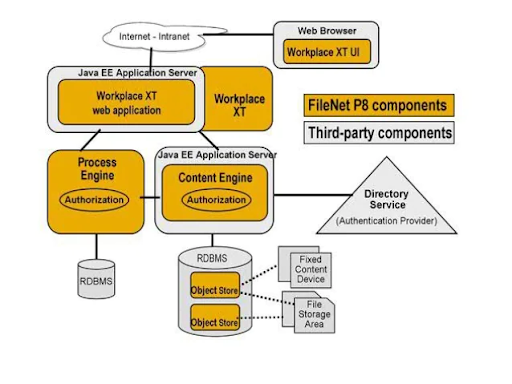
46.Write the variations between work and work XT?
Ans:
| Workplace | Workplace XT |
|---|---|
| The work is supported by FileNet P8 three.8 however the newer versions of FileNet P8 like FileNet P8 P4 support work XT. work XT could be a new edition of the work.It’s quicker and easier | The work provides dedicated tools for customizing the work however work XT doesn’t support customization in the slightest degree. It’s a stronger folder structure. |
47.Describe what P8 suggests in FileNet P8?
Ans:
FileNet consists of eight merchandise thus P8 suggests that eight merchandise. Following are the eight merchandise.
- Content Manager
- Records Manager
- Team Collaboration Manager
- Business method Manager
- Web Content Manager
- Image Manager
- Forms Manager
- Email Manager
48. Where are documents kept in the FileNet Content Engine?
Ans:
Documents will be kept in FileNet Content Engine when configuration at the subsequent locations.
- File Store.
- Fixed Storage Devices.
- Database (as blobs).
49.What is a File Store?
Ans:
FileNet stores documents in an exceedingly physical folder referred to as File Store. Multiple File Stores will be created in FileNet.
50. Make a case for the employment of Content Engine question Builder?
Ans:
Functions of Content Engine question Builder are:
- Using property values to seek out objects as a hunt criterion.
- Create, run, and save straightforward searches.
- Create, run, and save SQL queries.
- Create and save search templates that prompt for criteria after they are launched.
- Launch search templates.
51.Does FileNet element atomic number 58, PE, AE support server bunch5 What -kind of clustering is supported by FileNet P8?
Ans:
This includes FileNet Content Engine# method Engine and application Engine.s%mmetric clusters embody !it acti$e and passi$e ser$ers. i.e. just in case of s%metric 1-to-1 cluster# there is one active and another passi$e ser$er. 4is is the simplest type of bunch.,%metric clusters embody all the acti$e ser$ers. In ,%metric clusters totally different|completely different} ser$ersrun different ser$ices !ut just in case of fail o$er# multiple ser$ices are mo$ed on to oneser$er.Please note* 5ile FileNet CE# PE# E supports acti$e6acti$e clustering# FileNet Supports websites acti$e6passi$e bunch.
52.Which protocol is employed by FileNet P method Engine !PE” to attach to ContentEngine !CE” or Application Engine !AE
Ans:
##:P is employed !% letter of the alphabet to speak & it atomic number 58 and E.II7P suggests that eight #internet #inter*:.’ Protocol eight7B suggests that 8 :b)ect .e+uest ‘ro-e.
53.What is the FN P domain?
Ans:
FileNet P” domain represents a logical grouping of derisory resources (suc aso!).Ser$er will access a number of advantages resource in the domain# !but cannot access a number of advantages that lie outside of the domain.4e atomic number 58 9lo!al Configuration /ata (9C/) database stores info a!
54. What’s the association between the IBM FileNet connective for the Salesforce app and also the IBM FileNet Content Engine server?
Ans:
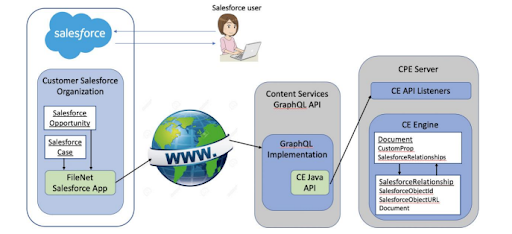
55.What is FileNet ‘business Frame?
Ans:
FileNet BPF pro$ides a configurable frame or’ for fast de$elopment of BPMapplication. BPF 5e! application# associate :a !based application pro$ides a user friendly%interface to the !business users.long it the pre outlined screens and functionality%# FileNet BPF pro$ides a frame or’ to de$elop and customize the application to satisfy !business reuirement.FileNet BPF as t&o elements*BPF 5e! application* /eplo%ed on a A2EE ser$er# te BPF 5e! application is about-of-te-!o# customize!le# and configurable portal for beats per minute applications# and a?I instrumentality & it real$ant components for WPF applications.BPF Explorer* BPF Explorer could be a Microsoft Management Console (MMC)-!based tool for shaping and configuring BPF applications.
56.How does one delete a document victimization code?
Ans:
A document object is deleted from FileNet Content Engine (CE) victimization .delete() technique.
Following steps is followed to delete a document:
- Instantiate the item victimization getInstance or fetchInstance.Call ‘delete’ technique to feature delete operation to the objects PendingActions.
- Call ‘save’ to perform the delete operation.
Following Java code demonstrates the deletion of a document hold on in FileNet Content Engine:
- // Get the item
- Document doc = works.Document.getInstance(os,”Document”,”/Doc”);
- // Mark the document for deletion regionally
- doc.delete();
- // Perform the delete
- doc.save(Refresh.NO_REFRESH);
57.On that technology FileNet metallic element is built and wherever is it installed?
Ans:
IBM FileNet Version five.0 onwards, following at the bottom softwares needed for FileNet metallic element installation:
- A Content Engine application server, such as WebSphere, WebLogic, JBoss, etc.
- A Directory Server, for authentication and authorization of all FileNet P8 elements.
- Two or a lot of information, one for the GCD information and remaining for object store knowledge.
- File System / device (optional), just in case documents are held the classification system.
- Load Balancer (optional) for top handiness.
58. What’s Content Management Portfolio?
Ans:
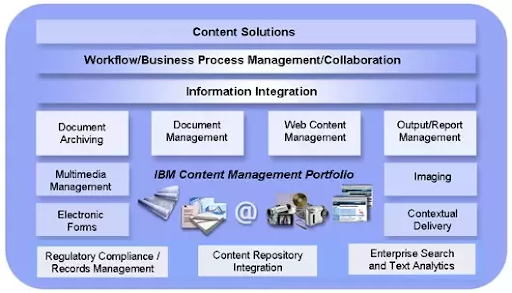
59. Why would we like custom objects once we will store the data in a very separate database?
Ans:
Custom objects in FileNet metallic elements are the same as rows representing the gathering of knowledge in a very information table. In associate application devolve on ECM platform, custom object provides multiple advantages over storing the data in a very separate database:
- Security of knowledge “ constant access management principles are obligatory on Custom Objects that are obligatory on content objects.
- Custom Objects support events and auditing.
- Custom Objects will participate in business processes or records management even as traditional documents will do.
- Custom objects are connected simply to different objects that are maintained within the Content Engine utilizing Link Objects.
60.How FileNet Content Engine authenticates the requests?
Ans:
Authentication over the EJB transport is protractible through use of the JAAS normal. The J2EE application server authenticates callers before they will access the EJB. Internet Service Protractible Authentication Framework (WS-EAF) provides a pluggable authentication mechanism for the online service transport. EAF is predicated on WS-Security OASIS normal and enforced with the JAAS normal.
The WS-Security normal defines however security credentials are formatted and inserted in a very internet service request. Once an online service request arrives within the Content Engine server, the Content Engine internet service hearer extracts the WS-Security header and performs a JAAS login supporting its contents. If this JAAS login is fortunate, then the online service hearer passes the request to the Content Engine EJB layer inside the EJB instrumentality.
61. Discuss the variations between FileNet P8 three.5 and FileNet P8 four.0 versions?
Ans:
| FileNet P8 three.5 | FileNet P8 four.0 |
|---|---|
| The first version of Content Engine was written in C++ and implemented as a Windows service. It is possible that Content Engine is a Java-based solution that operates in a J2EE application server environment. | To facilitate interaction between the AE and metals component, version 3.5.2 made use of SOAP via port 8008. These engines will exchange data in version 4.0 using either the standard EJB transport or the internet services transport. |
62.How to transfer IBM FileNet P8 computer code for path or training?
Ans:
There are multiple ways that to induce FileNet software’s for coaching or development purposes:
- IBM FileNet P8 product suite for development / coaching atmosphere is rented from IBM for attiny low monthly value.
- If your company is an associate IBM partner, you’ll be able to get the IBM FileNet P8 VMware image from IBM specially designed for coaching.
- This VMware image comes with Windows 2003 OS and full set of FileNet P8 merchandise / coaching put in thereon.
- The size of this VM image varies from fifteen GB to fifty GB and it needs a minimum of a pair of GB of RAM on your machine to run it.
63. ACL’s (Access management List)
Ans:
ACL could be a cluster of access rights dominant that actions are performed on a given object by a given user or cluster. for instance actions together with viewing content, change content, change data, change access rights, and business.
Each category is formed with a Default Instance Security ACL, that is inheritable by objects held in it. One or a lot of ACLs is applied to associate objects.
The task of mapping associate access right to a user or cluster is supported by the authorization framework, that manages the user and cluster look-up within the designed LDAP repository or repositories.
64. What’s Marking Sets?
Ans:
FileNet Content Engine (CE) Markings or Marking Sets provides some way to outline A level of security on objects (i.e. documents) additionally to the conventional FileNet P8 object security model.
By victimization markings, access to things is controlled and supported by specific property prices. Click here to scan a lot of concerning Marking Sets.
65. Mention the online Services Security (WS-Security) standard?
Ans:
FileNet net services use WS-Security standards for authentication. Like JAAS, WS-Security is associate degree extensile customary that supports multiple security token formats i.e.
When the Content Engine server receives an online service request, the Content Engine net Service auditor extracts the WS-Security header and performs a JAAS login supporting its contents. If this JAAS login is fortunate, then the online service auditor passes the request onto the Content Engine EJB layer inside the EJB instrumentation.
66. A way to Delete A Queue In Method Engine?
Ans:
FileNet doesn’t offer any mechanism to delete a queue; whether or not or not it’s a piece queue or a part queue.The most effective workaround is to initialize the remoted place in following manner:Export remoted region configuration information to XML – Use method Configuration Console (PCC) to export all additives of chosen remoted region.Initialize a isolated place.Take a backup of XML report from the export in step one and punctiliously edit the XML record to get rid of the nodes of unwanted queue.Import the XML report in presently initialized isolated place with the choice ‘overwrite’.Validate the configuration.
67.What is association purpose in FileNet?
Ans:
Connection points replace the router method employed in previous method Engine releases, connecting the method Engine API to associate degree associated isolated region.
68.How to produce association purposes in FileNet?
Ans:
Start the New association purpose wizard within the administration console: For a progress system: within the domain navigation pane, click the thing store. within the object store navigation tree, right-click the executive > progress System > association purposes folder and click on New association Point.
69.What are events and subscriptions in FileNet?
Ans:
For example, making a document in an associate degree object store triggers a product event that launches a progress that approves the new document and posts the approved content to a web site. A subscription is the association of a specific event trigger with an occasion action.
70. What IBM FileNet Content Manager information varieties for Kofax Capture text constants?
Ans:
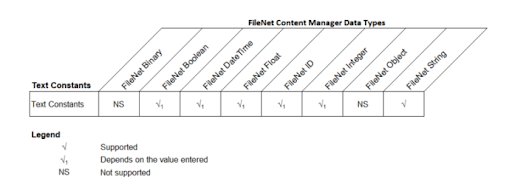
71.How do I add an occasional subscription to FileNet?
Ans:
Creating a subscription:
- Start the New Subscription wizard within the administration console: possibility. Description. From the category or object.
- In the domain navigation pane, choose the thing store. within the object store navigation pane, click the category or object that you simply wish to make the subscription for.
- Complete the wizard.
72.What is the code module in FileNet?
Ans:
A code module is a Content Engine object that contains one or a lot of Java action handlers and any supporting libraries. Code modules are mechanically offered once the Content Engine is deployed to multiple application server instances, or moving your content data from one system to a different.
73.What is a FileNet server?
Ans:
The FileNet P8 domain represents a logical grouping of physical resources and therefore the Content Platform Engine servers that offer access to those resources. The servers in an exceedingly FileNet P8 domain are platform-independent and may be in separate Java applied science domains.
74.What is geographical point XT?
Ans:
Workplace disturbance is an associate degree elective FileNet® P8 platform element (similar to Application Engine) that hosts the geographical point disturbance net application, providing access to the method and content practicality of FileNet P8. you’ll be able to install geographical point disturbance additionally to or in situ of Application Engine.
75.What Is the Importance Of Folders In Filenet P8?
Ans:
In FileNet, Folders are accustomed to cluster different objects as well as documents and custom objects. As folders in windows, FileNet folders offer the simplest way to flick through FileNet objects. Folder’s help in organizing the documents and different things. A document is filed to multiple folders. FileNet will produce copies of documents during this case. It truly creates a logical association between the folder and therefore the document.
Few necessary facts concerning folders:
- Folders don’t seem to be versionable; solely documents are.
- Folders are supported in the Ce folder category.
- Content of a folder is traced to a different folder that exists in the same object store.
- It is not necessary that every document or object ought to be filed beneath a folder. Documents that don’t seem to be a part of any folder stay Unfile.
- A Root Folder is made at the side of a replacement Object Store. This folder is the parent folder for all different folders within the Object Store.
- Each Folder has its own custom security.
- Folders will generate server events once they are created, modified, or deleted.
76. What’s ‘Workflow Roster’?
Ans:
‘Workflow Roster’ may be an information structure that stores data concerning all workflows (or work items) in an associate degree isolated region. Progress listing is a component of method Engine VW information. Progress rosters offer the method Engine with associate degree economical thanks to finding specific workflows.
When we initialize a replacement isolated reason in the method engine, a listing known as DefaultRoster is made for that isolated reason. Further rosters are created from the victimization method Configuration Console (PCC) to straightforward body tasks.
77. What’s Filenet Business Framework (bpf)?
Ans:
FileNet BPF provides a configurable framework for fast development of beats per minute application. BPF net Application, associate degree Ajax primarily based application provides a user friendly interface to the business users.
Along with the pre outlined screens and practicality, FileNet BPF provides a framework to develop and customize the application to fulfill business demand.
FileNet BPF has 2 components:
BPF net Application: Deployed on a J2EE server, the BPF net Application is associate degree out-of-the-box, customizable, and configurable portal for beats per minute applications, and a UI instrumentality with relevant parts for BPF applications.
BPF mortal: BPF Explorer may be a Microsoft Management Console (MMC)-based tool for outlining and configuring BPF applications.
78. Outline event actions & subscriptions?
Ans:
There is a framework provided by Content Engine for providing user-implemented actions once custom or system events on Content Engine objects are triggered. a happening action is outlined as a user-implemented action. A developer codes a happening action. Once some actions like object creation, object modification, associate degreed object deletion area unit performed in associate degree object store, it triggers some events. For instance, the ‘create event’ is triggered once a document is formed in an associate degree object-store. The product event launches a workflow to approve the new document and post the content approved to an internet site. Here the creation of the document is that the event trigger and therefore the launch of work flow is that the event action. The creation of the documents results in the launch of the workflow.
79. Why does the general public opt for Java in FileNet implementation?
Ans:
FileNet Content Engine (CE), method Engine five.X (PE) and Application Engine (AE); all area unit J2EE applications put in on J2EE Application Servers i.e. IBM WebSphere App Server. (Note alphabetic character was a C++ app before FileNet P8 Business method Manager five.x
There area unit 2 ways that for different applications (FileNet internal also as external application or custom applications) to speak to FileNet Ce:
- EJB transport the EJB transport is an associate degree Enterprise Java Bean (EJB) that runs within the J2EE EJB instrumentality of the application server that hosts the Content Engine Service.
- The EJB transport will solely be accessed through the Content Engine Java API. This can be the quickest approach to accessing Ce.
80. What area unit events in FileNet?
Ans:
Events give a mechanism for initiating actions that area units invoked once objects are created and changed in, and deleted from, an object store.
81. Variations between hold on search and search guide
Ans:
| Stored search | Search guide |
|---|---|
| Stored search is complete search. | Search templates area unit for a part completed search wherever users area unit promoted for search criteria. |
| Stored search executes mechanically once opened. | Search guide permits users to fill the search criteria and perform search. |
82.Explain the method summary once the environment area unit is connected?
Ans:
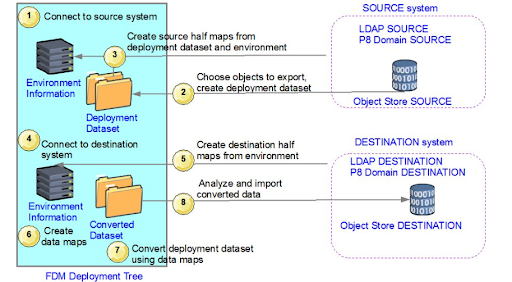
83.What is FileNet Content Engine?
Ans:
Content Platform Engine may be a FileNet® P8 element that’s designed to handle the serious demands of an outsized enterprise. It will manage enterprise-wide workflow objects, custom objects, and documents by providing powerful and easy-to-use administration tools.
84. However does one access FileNet?
Ans:
- Access FileNet P8 victimization integrated workplace applications.
- In the Logon window, enter your user name and positive identification.
- If your administrator has designed single-sign on capability, wherever your Windows login data is employed to go online to FileNet P8, you may not see this window.
- If necessary, enter the online address.
85. What tool will FileNet Content Manager use to feature cases?
Ans:
To change case employees to feature a duplicate of a Box document to this case, change the Box copy feature for the case management repository. within the IBM Content Navigator administration tool, click Repositories and open the IBM FileNet Content Manager target object store that’s used because of the case management repository.
86. What’s FileNet image services?
Ans:
IBM FileNet Image Services helps your organization store and manage giant volumes of mounted data with high availableness to users. The services give quick, security-rich access to enterprise content and documents.
87. What’s FileNet IDM?
Ans:
FileNet Integrated Document Management (IDM) Desktop may be a thick consumer primarily based electronic document management system that has access to International Business Machines (IBM) FileNet Content repositories, Image Services (IS) and Content Services (CS) libraries.
88. What’s the role of a FileNet developer?
Ans:
FileNet Integrated Document Management (IDM) Desktop may be a thick consumer primarily based electronic document management system that has access to International Business Machines (IBM) FileNet Content repositories, Image Services (IS) and Content Services (CS) libraries.
89. What’s FileNet P8 domain entities?
Ans:
1.Site: A web site may be a geographical location wherever resources area unit connected through space|a neighborhood} area network.
2.Object store: Associate degree object store may be a repository for storing objects (such as documents, folders, and business objects) and therefore the data that defines the categories and properties of objects.
3.Index space: Associate degree index area may be an instrumentality for one or additional indexes, that area unit accustomed to perform full-text searches against documents in associate degree object store.
90. Wherever FileNet Content Engine (CE) physically stores documents?
Ans:
FileNet Content Engine is designed to store documents at following places:
- In info as blobs (IBM suggested most document size to store as blob is ten KB).
- In File Store.
- In storage Devices (like EMC Centera).
91. Is FileNet a SAAS?
Ans:
Moving to the cloud will involve 2 forms of platforms: software system as a Service (SAAS) – a suppliers’ ECM cloud surroundings wherever the provider offers software system and infrastructure maintenance. e.g., FileNet with IBM’s cloud or Documentum/OpenText with their own proprietary SAAS surroundings.
Are you looking training with Right Jobs?
Contact Us- Hadoop Interview Questions and Answers
- Apache Spark Tutorial
- Hadoop Mapreduce tutorial
- Apache Storm Tutorial
- Apache Spark & Scala Tutorial
Related Articles
Popular Courses
- Hadoop Developer Training
11025 Learners - Apache Spark With Scala Training
12022 Learners - Apache Storm Training
11141 Learners
- What is Dimension Reduction? | Know the techniques
- Difference between Data Lake vs Data Warehouse: A Complete Guide For Beginners with Best Practices
- What is Dimension Reduction? | Know the techniques
- What does the Yield keyword do and How to use Yield in python ? [ OverView ]
- Agile Sprint Planning | Everything You Need to Know
